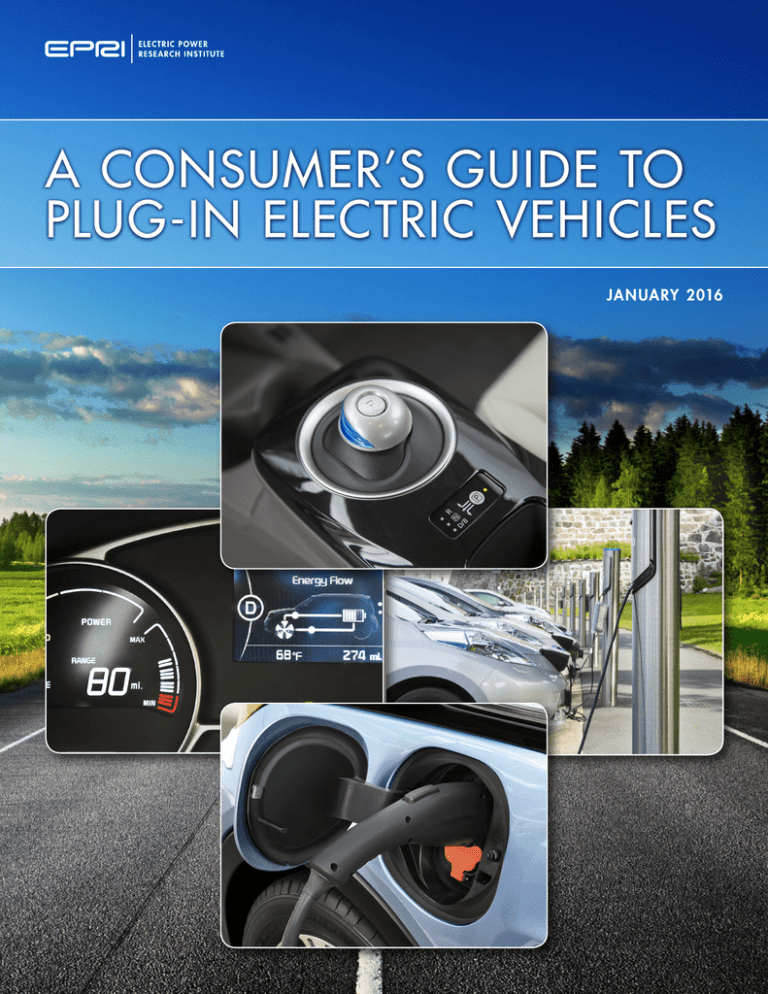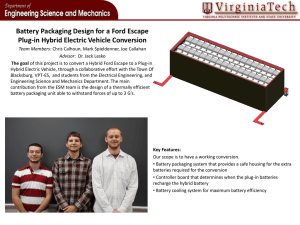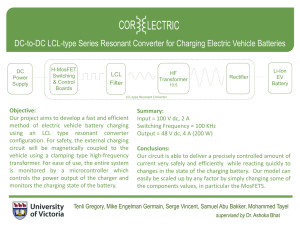
A CONSUMER’S GUIDE TO
PLUG-IN ELECTRIC VEHICLES
JANUARY 2016
Today’s Choices in Cars
Plug-in Electric Vehicles
Plug-in electric vehicles are arriving in dealer
showrooms across the country, bringing new
car buyers a high-tech, clean vehicle option.
Today, major automakers offer 24 models.
Soon, American consumers will have even more
choices as the industry invests in technologies
to improve fuel economy, reduce emissions, and
advance vehicle connectivity.
Plug-in electric vehicles have batteries that recharge by
plugging into the electricity grid. There are two main
types. Plug-in hybrid electric vehicles (plug-in hybrids)
are powered by an electric motor(s) and battery paired
with an internal combustion engine. Battery electric
vehicles are powered by an electric motor and battery
alone; they never use gasoline.
Plug-in electric cars offer performance, comfort,
and safety. With plug-in cars, drivers benefit
from convenient home charging using domestic
electric fuel and save money over time. At
the U.S. national average price of 12.5 cents
per kilowatt-hour (kWh), buying electricity is
Plug-in hybrid designs differ. Most drive on electricity alone
using battery energy, and after the battery is discharged,
continue driving using gasoline much like conventional
hybrids. (Conventional hybrids have a smaller battery and
do not plug in.) Some plug-in hybrids can travel 50 miles
or more on electricity before they need to be plugged
in. Others travel short distances only—around 10 miles—
on electricity, and their gas tanks extend total range to
between 300 and 600 miles. Some designs allow the
driver to choose whether to use electricity or gasoline as
they drive.
roughly equivalent to buying gasoline at $1 per
gallon. Drivers can save even more with timeof-use rates offered by some utilities.
Displacing gasoline with electricity cuts
petroleum use and emissions, which benefits
public health. Electrifying the transportation
sector can reduce greenhouse gas emissions in
2050 by 52% to 60% relative to 2015 levels.
Buyers should evaluate their own driving needs
Battery electric vehicles can travel farther on electricity
than plug-in hybrids, but their total range is limited by their
battery size. Some current models can travel more than
200 miles between charges, however, most currently have
a range of 80 to 100 miles. Future models promise more
range—around 300 miles.
to determine how different plug-in electric
vehicle technologies can work for them.
2
Available Now Nationwide
These plug-in electric vehicles are available as of January 2016.
Photo courtesy of BMW
Photo courtesy of BMW
2016 BMW i3
2016 BMW i3 REx
The i3 battery electric vehicle is the first mass-produced car
to use carbon fiber for the body (instead of aluminum or
steel) to enhance strength and reduce weight.
EPA electric range: 81 miles
Charging time: 3.5 hours @ 240V; 20 hours @ 120V;
fast-charging capable
A variation of the i3, the i3 REx has a small internal
combustion engine to extend the car’s overall driving range.
EPA categorizes it as a plug-in hybrid.
EPA electric range: 72 miles
EPA total range (gas + electric): 150 miles
Charging time: 3.5 hours @ 240V; 20 hours @ 120V;
fast-charging capable
Photo courtesy of BMW
Photo courtesy of BMW
2016 BMW i8
2016 BMW X5 xDrive40e
This plug-in hybrid sport coupe is the second model released
under BMW’s “i” lineup. A three-cylinder engine drives the
back wheels and an electric motor drives the front wheels.
EPA electric range: 15 miles
EPA total range (gas + electric): 330 miles
Charging time: 2.5 hours @ 240V; 10 hours @ 120V
The X5 xDrive40e is the first plug-in hybrid production
model from the core BMW brand, and the company’s first
plug-in hybrid sport utility vehicle.
EPA electric range: 14 miles
EPA total range (gas + electric): 540 miles
Charging time: 2.75 hours @ 240V; 7 hours @120V
3
Photo courtesy of GM
Photo courtesy of GM
2016 Cadillac ELR
2016 Chevrolet Volt
The ELR plug-in hybrid, which General Motors calls an
extended-range electric vehicle, has a redesigned electric
drive system and a performance package option.
EPA electric range: 40 miles
EPA total range (gas + electric): 340 miles
Charging time: 5 hours @ 240V; 13 to 18 hours @ 120V
The second-generation Volt improves on the first generation
with a more efficient and lighter two-motor drive design for
enhanced acceleration and increased range.
EPA electric range: 53 miles
EPA total range (gas + electric): 420 miles
Charging time: 4.5 hours @ 240V; 13 hours @ 120V
Photo courtesy of Ford
Photo courtesy of Ford
2016 Ford C-MAX Energi
2016 Ford Focus Electric
The C-MAX Energi is the plug-in hybrid version of the
C-MAX conventional hybrid compact hatchback. An EV
mode button allows the driver to choose all-electric, gas
power, or a combination of both.
EPA electric range: 20 miles
EPA total range (gas + electric): 550 miles
Charging time: 2.5 hours @ 240V; 7 hours @ 120V
The Focus Electric is a battery electric version of the Focus
compact hatchback. The dashboard display on the 2016
model provides enhanced feedback to help the driver
improve driving efficiency.
EPA electric range: 76 miles
Charging time: 3.6 hours @ 240V; 20 hours @ 120V
4
Photo courtesy of Ford
Photo courtesy of Mitsubishi
2016 Ford Fusion Energi
2016 Mitsubishi i-MiEV
The Fusion Energi is a plug-in hybrid version of the Fusion
midsize sedan. An EV mode button allows the driver to
choose all-electric, gas power, or a combination of both.
EPA electric range: 20 miles
EPA total range (gas + electric): 550 miles
Charging time: 2.5 hours @ 240V; 7 hours @ 120V
The i-MiEV is a battery electric subcompact city car that
was introduced in the United States in 2012. MiEV is an
acronym for Mitsubishi innovative Electric Vehicle.
EPA electric range: 62 miles
Charging time: 6 hours @ 240V; 14 hours @ 120V;
fast-charging capable
Photo courtesy of Nissan
Photo courtesy of Porsche
2016 Nissan LEAF
2016 Porsche Cayenne S E-Hybrid
The LEAF was the first battery electric vehicle to enter the
U.S. market in late 2010. The updated LEAF comes with
a 24kWh or 30kWh battery. Data listed below is for
30kWh battery.
EPA electric range: 107 miles
Charging time: 6 hours @ 240V; 26 hours @ 120V;
fast-charging capable
The Cayenne S E-Hybrid is a plug-in hybrid version of the
Cayenne midsize performance crossover.
EPA electric range: 14 miles
EPA total range (gas + electric): 480 miles
Charging time: 1.3 to 2.7 hours @ 240V;
7.9 hours @ 120V
5
Photo courtesy of Porsche
Photo courtesy of Tesla
2016 Porsche Panamera S E-Hybrid
2016 Tesla Model S
The Panamera S E-Hybrid is a plug-in hybrid version of the
Panamera 4-door luxury performance sedan.
EPA electric range: 16 miles
EPA total range (gas + electric): 560 miles
Charging time: 2 to 3 hours @ 240V; 9.1 hours @ 120V
The Model S is a five-door battery electric vehicle luxury
sedan. It comes with different battery sizes (70kWh to 90kWh)
and performance options, which affect vehicle range.
EPA electric range: 234 to 270 miles
Charging time: 4.75 to 12 hours @ 240V; 58.8 to
75.6 hours @ 120V; fast-charging capable
Photo courtesy of Tesla
Photo courtesy of Volvo
2016 Tesla Model X
2016 Volvo XC90 T8 Twin Engine
The Model X is a battery electric vehicle that seats up to
seven people in three rows. It comes with different battery
sizes (70kWh to 90kWh) and performance options,
which affect vehicle range.
EPA electric range: 250 to 257 miles
Charging time: 4.75 to 12 hours @ 240V; 58.8 to
75.6 hours @ 120V; fast-charging capable
The XC90 T8 Twin Engine is the plug-in hybrid version of
the XC90 performance crossover, and the company’s first
plug-in electric vehicle on the market.
EPA electric range: 14 miles
EPA total range (gas + electric): 350 miles
Charging time: 2 hours @ 240V; 4 hours @ 120V
6
Available Now in Select Markets
Availability of some plug-in electric vehicles varies by state and manufacturer.
2016 Audi A3 Sportback e-tron
Design: Plug-in hybrid hatchback
EPA electric range: 16 miles
EPA total range (gas + electric): 380 miles
Charging time: 2.25 hours @ 240V; 8 hours @ 120V
Photo courtesy of Audi
2016 Chevrolet Spark Electric Vehicle
Design: Battery electric vehicle compact hatchback
EPA electric range: 82 miles
Charging time: 7 hours @ 240V; 18 hours @ 120V;
fast-charging capable
Photo courtesy of GM
2016 Fiat 500e
Design: Battery electric vehicle subcompact
EPA electric range: 87 miles
Charging time: 4 hours @ 240V; 24 hours @ 120V
2016 Hyundai Sonata Plug-in Hybrid
Design: Plug-in hybrid sedan
EPA electric range: 27 miles
EPA total range (gas + electric): 600 miles
Charging time: 3 hours @ 240V; 9 hours @ 120V
Photo courtesy of Hyundai
2016 Kia Soul EV
Design: Battery electric vehicle compact SUV
EPA electric range: 93 miles
Charging time: 5 hours @ 240V; 24 hours @ 120V;
fast-charging capable
Photo courtesy of Kia
7
2016 Mercedes-Benz B250e
Design: Battery electric vehicle hatchback
EPA electric range: 87 miles
Charging time: 3.5 hours @ 240V; 23.5 hours @ 120V
Photo courtesy of Mercedes-Benz
2016 Mercedes-Benz S550e
Design: Plug-in hybrid luxury sedan
EPA electric range: 14 miles
EPA total range (gas + electric): 450 miles
Charging time: 2.5 hours @ 240V; 7.3 hours @ 120V
Photo courtesy of Mercedes-Benz
2016 smart fortwo electric drive
Design: Battery electric vehicle subcompact
EPA electric range: 68 miles
Charging time: 6 hours @ 240V; 13 hours @ 120V
Photo courtesy of Mercedes-Benz
2016 Volkswagen e-Golf
Design: Battery electric vehicle hatchback
EPA electric range: 83 miles
Charging time: 4 to 7 hours @ 240V; 20 hours @ 120V;
fast charging capable
Photo courtesy of Volkswagen
8
Vehicle Availability at a Glance
Model Name
BMW i3
BMW i3 REx
BMW i8
BMW X5 xDrive40e
Cadillac ELR
Chevrolet Volt
Ford C-MAX Energi
Ford Focus Electric
Ford Fusion Energi
Mitsubishi i-MiEV
Nissan LEAF
Porsche Cayenne S E-Hybrid
Porsche Panamera S E-Hybrid
Tesla Model S
Tesla Model X
Volvo XC90 T8 Twin Engine
Audi A3 Sportback e-tron
Chevrolet Spark
Fiat 500e
Hyundai Sonata
Kia Soul EV
Mercedes-Benz B250e
Mercedes-Benz S550e
smart fortwo electric drive
Volkswagen e-Golf
Mercedes-Benz GLE550e
BMW 330e
BMW 740e xDrive
Audi Q7 e-tron
Cadillac CT6
Chevrolet Bolt
Chrysler Pacifica Hybrid
Ford Focus Electric (Gen. 1+)
Kia Optima
Mitsubishi Outlander
Toyota Prius Plug-in (Gen. 2)
Volvo V60
Volvo S90 T8 Twin Engine
BMW X3 edrive
BMW i3 (Gen. 1+)
Hyundai Ioniq
Kia Soul EV (Gen. 1+)
Tesla Model 3
VW e-Golf (Gen. 1+)
VW CrossCoupe
VW Tiguan
Audi e-tron Quattro
BMW i5
Nissan LEAF (Gen. 2)
Porsche Pajun
Subaru Crosstek XV
Jaguar F-Pace
VW Budd-e
Porsche Mission E
VW Phaeton
Plug-in Type
Body Style
Available Now
Battery electric vehicle
Hatchback
Plug-in hybrid
Hatchback
Plug-in hybrid
Sport coupe
Plug-in hybrid
SUV
Plug-in hybrid
Luxury sedan
Plug-in hybrid
Compact
Plug-in hybrid
Hatchback
Battery electric vehicle
Hatchback
Plug-in hybrid
Sedan
Battery electric vehicle
Subcompact
Battery electric vehicle
Hatchback
Plug-in hybrid
Crossover
Plug-in hybrid
Luxury sedan
Battery electric vehicle
Luxury sedan
Battery electric vehicle
Crossover
Plug-in hybrid
SUV
Plug-in hybrid
Hatchback
Battery electric vehicle
Compact hatchback
Battery electric vehicle
Subcompact
Plug-in hybrid
Sedan
Battery electric vehicle
Compact SUV
Battery electric vehicle
Hatchback
Plug-in hybrid
Luxury sedan
Battery electric vehicle
Subcompact
Battery electric vehicle
Hatchback
Coming Soon
Plug-in hybrid
SUV
Plug-in hybrid
Luxury sedan
Plug-in hybrid
Luxury sedan
Plug-in hybrid
SUV
Plug-in hybrid
Luxury sedan
Battery electric vehicle
Hatchback
Plug-in hybrid
Minivan
Battery electric vehicle
Hatchback
Plug-in hybrid
Midsize sedan
Plug-in hybrid
Crossover
Plug-in hybrid
Hatchback
Plug-in hybrid
Wagon
Plug-in hybrid
Luxury sedan
Coming Later and Concept Cars3
Plug-in hybrid
Crossover
Battery electric vehicle
Hatchback
Battery electric vehicle and Plug-in hybrid
Sedan
Battery electric vehicle
Compact SUV
Battery electric vehicle
Sedan and crossover
Battery electric vehicle
Hatchback
Plug-in hybrid
SUV
Plug-in Hybrid
Crossover
Battery electric vehicle
SUV
Plug-in hybrid
Luxury sedan
Battery electric vehicle
Hatchback
Battery electric vehicle
Luxury sedan
Plug-in hybrid
Crossover
Battery electric vehicle
Crossover
Battery electric vehicle
Van
Battery electric vehicle
Sports car
Battery electric vehicle
Luxury sedan
Range (miles)1
Availability2
81
72/150
15/330
14/540
40/340
53/420
20/550
76
20/550
62
107
14/480
16/560
234-270
250-257
14/350
16/380
82
87
27/600
93
87
14/450
68
83
Nationwide
Nationwide
Nationwide
Nationwide
Nationwide
Nationwide
Nationwide
Nationwide
Nationwide
Nationwide
Nationwide
Nationwide
Nationwide
Nationwide
Nationwide
Nationwide
Select Markets
Select Markets
Select Markets
Select Markets
Select Markets
Select Markets
Select Markets
Select Markets
Select Markets
TBA
22/370
23/TBA
25/TBA
30/TBA
200
30/TBA
100
TBA
TBA
TBA
TBA
TBA
Early 2016
Spring 2016
Summer 2016
Late 2016
Late 2016
Late 2016
Late 2016
Late 2016
Late 2016
Late 2016
Late 2016
Late 2016
Late 2016
20/TBA
120
TBA
TBA
200
108
20/TBA
TBA
300
TBA
200–300
220
TBA
300
233
TBA
TBA
2017
2017
2017
2017
2017
2017
2017
2017
2018
2018
2018–2020
2018
2018
2019
2019
TBA
TBA
1 Range for battery electric vehicles is all-electric range. Range for plug-in hybrids is all-electric/combined (electric + gas) range. On vehicles available now, source is www.fueleconomy.gov. On future cars, information source is
manufacturer or industry media. Subject to change.
2 Cars that are currently available are listed alphabetically by manufacturer. Future cars are listed chronologically by their expected market arrival date, then alphabetically by manufacturer.
3 Information source on availability of future cars is manufacturer or industry media. Subject to change.
9
Answers to Important Questions
How far do plug-in electric vehicles go on a
charge?
Some plug-in electric vehicle models are available now nationwide. Others are available only in California, Oregon, and
some Northeast states. With new technologies, manufacturers
face early production limitations and need to train and equip
dealers and service technicians, so they typically roll out plug-in
electric vehicles in select markets, then expand availability in
response to market demand and readiness.
Depending on battery size and vehicle design, plug-in hybrids
can typically drive from 11 to 53 miles between charges, and
about 300 to 600 miles on gasoline. If the vehicle is plugged
in every day as recommended, often at home or at work, it may
be possible to drive 1,000 to 2,000 miles or more between
gasoline fill-ups.
How, when, and where will I charge?
The advertised range of battery electric vehicles varies by model
from about 60 to 270 miles, but most current models are in the
80- to 100-mile range. Each driver’s experience is different.
Range depends heavily on the driver’s individual driving habits,
weather, and environmental conditions. A new battery electric
vehicle driver can to expect to achieve about 80% of the advertised range.
You can charge your plug-in electric vehicle’s battery any time
you have access to an outlet or charging station—but you will
probably find it most convenient to charge at home, overnight.
Many utilities offer lower time-of-use or special plug-in electric
vehicle rates to encourage charging overnight when electricity is
plentiful.
Studies show that limited range is less problematic for most
battery electric vehicle drivers than they initially expected. Most
drivers find their daily driving is well within the vehicle’s range.
On days with more driving, they use public or workplace charging during the day or swap cars with another member of their
household. Many drivers become comfortable enough with the
vehicle’s range to drive for a couple of days between charges.
You can plug into a standard 120V outlet (like most household
appliances) using the cord that comes with the car, or you can
install a 240V charging station for faster charging. Charging
time will vary based on the car’s battery size and onboard
charger capacity, and the electrical circuit’s capacity. Dedicated
240V charging stations provide 3kW to 7kW—about the same
power draw as a residential clothes dryer or an air-conditioning
system. All vehicles except Tesla are equipped with standard
connectors. (Tesla has its own connector.)
What environmental factors could affect
vehicle performance?
During very hot or very cold weather, and in certain driving
conditions, energy that would otherwise power the plug-in electric
vehicle is needed for interior air-conditioning, heating, and window defrosting or defogging. Although this energy use is much
less than that required to actually move the car, it may reduce
driving range. To balance these extreme temperature effects,
plug-in electric vehicles can be programmed to pre-condition the
car interior and battery while plugged in. Automakers continue to
make progress on technologies that reduce these effects. Windshield wipers, headlights, and similar accessories do not have a
significant effect on range.
Sometimes you may need to charge away from home. Many
cities, states, and private companies are establishing public
and workplace charging locations. Nationwide, this charging
network is growing rapidly, especially in markets where plug-in
electric vehicle sales are robust. Several subscription charging
services offer smartphone apps that communicate with your
car’s charging software, or locate and guide you to the nearest
charging station. Despite the charging network growth, every
region is different, and some places have limited or no public
infrastructure.
In addition to 120V and 240V charging, fast-charging networks
are expanding across the country. A fast charger can charge
a properly equipped battery electric vehicle to 80% full in 30
minutes or less. Not all vehicles, however, are fast-charging
capable. Tesla has developed its own Supercharger
fast-charging network exclusively to serve Tesla drivers.
What styles of plug-in electric vehicles are
available, and where?
Most currently available plug-in electric vehicles are compact
hatchbacks or sedans, but mid-size sedans, crossovers, and
SUVs are coming soon. The plug-in electric vehicle market will
evolve the way the hybrid car market developed during its first
decade; conventional hybrids are now available in nearly all
vehicle classes.
10
What incentives are available?
Consider environmental benefits. Plug-in electric vehicles
have lower emissions than gasoline-powered vehicles, even
in areas where much of the electricity is generated by power
plants that use fossil fuels such as coal or natural gas. For more
information, read EPRI publication, “Environmental Assessment
of Plug-In Hybrid Electric Vehicles” (Product ID 1015325). For
detailed information, consider the three-volume EPRI-NRDC
study, “Environmental Assessment of a Full Electric Transportation Portfolio” (Product IDs 3002006875, 3002006876, and
3002006880).
The federal government offers a tax credit of up to $7,500
toward the purchase of a qualified plug-in electric vehicle. Many
states and some counties offer vehicle purchase incentives and
rebates. Other incentives are available for the purchase or
installation of a charging station. In some urban areas, plug-in
electric vehicles are granted access to carpool lanes with a
single driver. Other perks, such as free or priority parking and
free charging are available in many cities. These incentives are
designed to entice consumers to consider purchasing a plug-in
electric vehicle. They are subject to limitations and may change
over time.
How can I learn more?
Explore automakers’ websites for product updates and check
your local electric utility website for information about plug-in
electric vehicles. Other sources:
What should I consider in making a
purchase?
Electric Drive Transportation Association
www.electricdrive.org and www.goelectricdrive.com
Consider your driving needs and lifestyle. If you have only one
car, or often drive long distances, a plug-in hybrid could be a
good choice. With their back-up internal combustion engine,
plug-in hybrids provide a worry-free transition to electric-drive
vehicles. If you have a second place to charge during the day,
typically at work, you can effectively double the electric range
of your plug-in hybrid.
U.S. Dept. of Energy Alternative Fuels Data Center
www.afdc.energy.gov/fuels/electricity.html
U.S. Dept. of Energy Fuel Economy Information
http://www.fueleconomy.gov/
Plug In America
www.pluginamerica.org
If you have a predictable commute, access to a second car for
long trips, or if the idea of a gasoline-free driving experience
appeals to you, a battery electric vehicle could be a good
choice. Battery electric vehicles have larger batteries than plugin hybrids and can usually drive more electric miles per day.
Their limited range, however, requires you to carefully consider
your needs. If you have access to workplace or public charging,
you may be able to charge when necessary, alleviating any
range concerns.
Consider costs and benefits. With manufacturer lease options,
utility time-of-use rates, and government purchase incentives,
plug-in electric vehicles can be less expensive to operate over
their lifetime despite costing more at first. For more information,
read EPRI publication, “Total Cost of Ownership for Current Plugin Electric Vehicles: Update to Model 2013 and 2014 Model
Year Vehicles” (Product ID 3002004054).
11
The Electric Power Research Institute, Inc.
(EPRI, www.epri.com) conducts research and
development relating to the generation, delivery
and use of electricity for the benefit of the public.
An independent, nonprofit organization, EPRI
brings together its scientists and engineers as well
as experts from academia and industry to help
address challenges in electricity, including reliability, efficiency, affordability, health, safety and the
environment. EPRI also provides technology, policy
and economic analyses to drive long-range research
and development planning, and supports research
in emerging technologies. EPRI members represent
90% of the electric utility revenue in the United States
with international participation in 35 countries.
EPRI’s principal offices and laboratories are located
in Palo Alto, Calif.; Charlotte, N.C.; Knoxville, Tenn.;
and Lenox, Mass.
Together . . . Shaping the Future of Electricity
©2016 Electric Power Research Institute (EPRI), Inc. All rights
reserved. Electric Power Research Institute, EPRI, and TOGETHER…
SHAPING THE FUTURE OF ELECTRICITY are registered service marks
of the Electric Power Research Institute.
Printed on recycled paper in the United States of America
3002005948
3420 Hillview Avenue, Palo Alto, California 94304-1338 • PO Box 10412, Palo Alto, California 94303-0813 • USA
800.313.3774 • 650.855.2121 • askepri@ epri.com • www.epri.com



